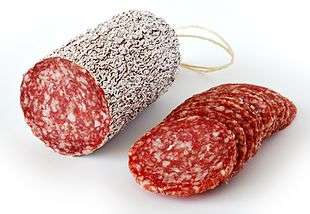Bologna sausage
Bologna sausage, sometimes called baloney (/bəˈloʊni/)[1] and known in South African English as polony, is a sausage derived from mortadella, a similar-looking, finely ground pork sausage containing cubes of pork fat, originally from the Italian city of Bologna (IPA: [boˈloɲɲa] (![]()
Lebanon bologna
Lebanon bologna is a Pennsylvania Dutch prepared meat. While nominally bologna, it is a dried, smoked sausage similar to salami.
Ring bologna
.jpg)
Ring bologna is much smaller in diameter than standard bologna. It is better suited for slicing and serving on crackers as a snack or hors d'oeuvre. It is generally sold as an entire link rather than sliced. The link is arranged as a semicircle or "ring" when prepared for sale (hence the name).[4] Pickled bologna is usually made from ring bologna soaked in vinegar and typical pickling spices.[5] It is usually served in chunks as a cold snack.
Rag bologna
Rag bologna is a long stick, or "chub", of high-fat bologna traditionally sold wrapped in a cloth rag. The recipe has a higher content of filler than that of regular bologna. Milk solids, flour, cereal, and spices are added during processing, and the roll of bologna is bathed in lactic acid before being coated in paraffin wax. This type of bologna is native to West Tennessee[6] and the surrounding regions and is not commonly available outside this area. It is generally eaten on white bread with mustard and pickles, but is also a staple of family gatherings, where thick slices are smoked and barbecued along with other meats.[7] In Newfoundland, a type of rag bologna referred to as "wax" bologna is sliced thickly and fried, which is referred to as "Newfie steak".
South African polony
South Africans refer to bologna exclusively as polony, although South African polony is typically made using highly processed meat. These processed meat products are typically an artificially bright pink color, and are foods for low-income people due to their low cost. Very small sausages of the same content and color are also called polonies in New Zealand and Australia. Large pink, bland polonies are called French polony, with thinner rolls referred to simply as polony. Garlic Polony is also widely available.
In 2018, a South African factory that produced polony and other processed meats was associated with the deadliest listeriosis outbreak in history, that sickened 1000 people, and killed at least 180.[8]
Vegetarian bologna
Various vegetarian and vegan versions of bologna are available. A typical UK recipe uses soya and wheat protein in the place of lean meat and palm oil instead of fat together with starch, carrageenan, and flavorings. It can be eaten cold or cooked in the same ways as traditional bologna.[9]
See also
- Bologna sandwich
- Chả lụa - a Vietnamese sausage, similar to bologna
- Falukorv
- Leberkäse
References
- ↑ "baloney." Dictionary.com Unabridged. Random House, Inc. 14 October 2011.
- ↑ "What The Heck Is In Bologna, Anyway?". Huffington Post. 24 October 2013.
- ↑ "Hot Dogs and Food Safety".
- ↑ "What is Ring Bologna". wiseGeek. Retrieved 27 August 2014.
- ↑ In the Midwest, Great Bologna Is a Way of Life, Sara Bir, 3 November 2014
- ↑ "Fineberg Packing Co., Inc". Fineberg Packing Co., Inc. Retrieved 17 December 2014.
- ↑ Randal, Oulton, (11 August 2004). "Rag Baloney". CooksInfo.com.
- ↑ "Enterprise polony identified as source of listeria outbreak".
- ↑ "Slicing Sausage / Bologna - Fry Family Food". 16 July 2016.
